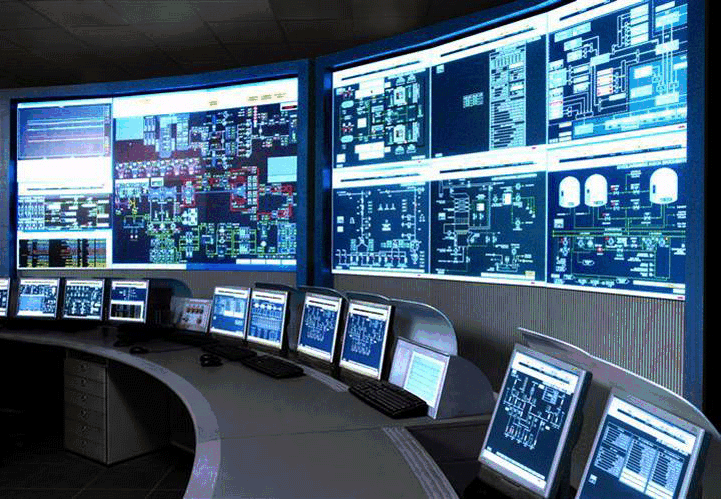What is SCADA?
SCADA system definition
= systems that monitor, control and gather data from technological processes.
SCADA systems in general do not represent main control system of the corresponding technology, but focus more on continuous monitoring and parametrization. So the SCADA type of software is operated on a higher level above the hardware (PLC device, I/O modules, dataloggers, sensors, counters, meters ..) that connects and gathers data from the technological processes.
SCADA systems can communicate with the surrounding technological environment through specialized industrial links/networks (RS-232, RS-485, Profibus, ...). But recent development in the SCADA technologies increasingly prefers the usage of normal computer networks of the Ethernet type. On these links/networks the communication now usually use standardized communication protocols (Modbus, M-BUS, S7, SNMP, BACnet, ...).
SCADA systems are highly scalable so the number of processed variables may vary from few to hundreds of thousands based on the complexity and extensity of the monitored technology.
SCADA systems use multiple methods to gather and store data. The technologies of data storage vary from simple local files to SQL database servers that are able to store massive amounts of data with very high sampling frequencies.
SCADA systems are now able to integrate Web technologies and this way provide remote access to the technology monitoring systems via the Internet. This way it is possible to monitor technologies not only on normal PCs, but also on tablets, smartphones, etc.
SCADA systems are used in all sectors where it is necessary to gather technological data and monitor the correct progression of processes, e.g.: energetics (power plants, heating plants, switchrooms, exchanger stations, ...), manufacturing (production lines, smelting plants, chemical plants, packaging lines, warehouses, ...), building management (air conditioning, security, access systems,...), ecology (emissions monitoring, water treatment plants, ...) and many other.
SCADA systems are now much more affordable than in the past and therefore penetrate new areas outside industry sectors – for example family houses, ... and are used by technological enthusiasts in other areas.
 SCADA history
SCADA history
1st generation - isolated systems
2nd generation - distributed systems
3rd generation - network systems
4th generation - "internet of things"
- Supervisory
- Control
- And
- Data
- Acquisition
= systems that monitor, control and gather data from technological processes.
SCADA systems in general do not represent main control system of the corresponding technology, but focus more on continuous monitoring and parametrization. So the SCADA type of software is operated on a higher level above the hardware (PLC device, I/O modules, dataloggers, sensors, counters, meters ..) that connects and gathers data from the technological processes.
SCADA systems can communicate with the surrounding technological environment through specialized industrial links/networks (RS-232, RS-485, Profibus, ...). But recent development in the SCADA technologies increasingly prefers the usage of normal computer networks of the Ethernet type. On these links/networks the communication now usually use standardized communication protocols (Modbus, M-BUS, S7, SNMP, BACnet, ...).
SCADA systems are highly scalable so the number of processed variables may vary from few to hundreds of thousands based on the complexity and extensity of the monitored technology.
SCADA systems use multiple methods to gather and store data. The technologies of data storage vary from simple local files to SQL database servers that are able to store massive amounts of data with very high sampling frequencies.
SCADA systems are now able to integrate Web technologies and this way provide remote access to the technology monitoring systems via the Internet. This way it is possible to monitor technologies not only on normal PCs, but also on tablets, smartphones, etc.
SCADA systems are used in all sectors where it is necessary to gather technological data and monitor the correct progression of processes, e.g.: energetics (power plants, heating plants, switchrooms, exchanger stations, ...), manufacturing (production lines, smelting plants, chemical plants, packaging lines, warehouses, ...), building management (air conditioning, security, access systems,...), ecology (emissions monitoring, water treatment plants, ...) and many other.
SCADA systems are now much more affordable than in the past and therefore penetrate new areas outside industry sectors – for example family houses, ... and are used by technological enthusiasts in other areas.
 SCADA history
SCADA history
- boom in industrial developed countris in sixties of the 20th century
- centralized, hierarchic, isolated architecture (mainframe, terminals)
- proprietal closed communication protocols (not standardized)
- high level of expertise demanded from personnel (high number of users)
- high costs of implementation and operation
1st generation - isolated systems
- isolated, expensive, single purpose systems
- central enterprise mainframe < – > access
2nd generation - distributed systems
- interconnection of multiple smaller stations by proprietary (closed, unpublished) communication protocols
- stations are function-specific
3rd generation - network systems
- boom of computer networking
- usage of open, standardized communication protocols
- station interconnection – PCN (Process Control Network)
4th generation - "internet of things"
- almost everything is connected to the Internet network
- cloud services are starting to dominate
See also:
PROMOTIC 9.0.27 SCADA system documentation MICROSYS, spol. s r.o.
Send page remarkContact responsible person
Send page remarkContact responsible person
Navigation:
- What is SCADA?